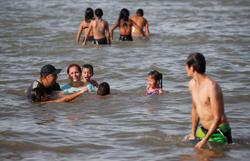Experts warn of wet-bulb temperatures for those vulnerable to heatstroke
Preparing for Extreme Heat
Tips on how to stay safe in hot weather
As global warming ratchets up, Malaysians should prepare to face hotter and muggier days during the dry spell brought about by the annual Southwest Monsoon, say weather experts.
Along with this, it is also time to pay attention to not just dry-bulb readings provided by the typical thermometer but also wet-bulb temperatures (WBT), which scientists say are important to those who are vulnerable to heatstrokes or related ailments.
WBT is an indication of how much the air can be cooled by the evaporation of water into it and is usually measured using a thermometer with the bulb covered by a wet membrane, with higher WBT signalling an increased risk for the vulnerable.
WBT and high humidity are often missed during reporting on heatwaves, even though they play a huge role in how a person experiences heat.
Academy of Sciences Malaysia’s fellow Dr Fredolin Tangang said while the Southwest Monsoon season is usually marked by hot and dry weather, global warming could be contributing to even hotter conditions.
“According to the latest observation, the first quarter of 2025 was the second warmest year compared to the corresponding period in 2024, which was the warmest year on record.
“This despite La Nina being active during the first quarter of this year,” he said when contacted.
The APEC Climate Center in (South) Korea, he said, indicated that the surface air temperature over the Indo-pacific region is 80% above normal during the current monsoon period this year.
“Also, the sea surface temperature (SST) was forecasted to be above normal.
“High SST could drive higher relative humidity, and this increases the WBT and also the heat index, creating favourable conditions for heatstrokes,” he said.
Fredolin suggested that the relevant authorities should provide an early warning system to the public to be alert for excessive heat and humidity.
“More public announcements of the danger of heatstroke and how to avoid getting one should be regularly broadcast, while the public should not take lightly the extreme conditions that heighten the risk for heatstrokes,” he said.
A 2023 paper published by researchers from Universiti Teknologi Malaysia raised concerns about the future emergence of urban areas as hotspots for heat stress, particularly in peninsular Malaysia.
Their study showed a notable increase in the mean temperature over the peninsula, surpassing the global average, which could lead to a substantial increase in WBT, especially in dense urban regions.
According to National Antarctica Research Centre climatologist Prof Datuk Dr Azizan Abu Samah, there is a high chance the Asean region will see above-normal temperatures between June and August, based on several predictive models.
“The inter-monsoon period typically transitions into the Southwest Monsoon over the Asean region in June and will continue throughout the outlook period,” he said, while advising the people to minimise their exposure to the blistering sun as much as possible.
Meteorological Department’s (Metmalaysia) director-general Dr Mohd Hisham Mohd Anip said the main cause for current hot and humid weather is the Southwest Monsoon that began on May 10, with the phenomenon expected to continue until September.
“This monsoon typically brings dry weather to most parts of the country.
“However, thunderstorms and heavy rain may still occur from time to time,” he said.
Mohd Hisham added that the extended absence of rain over several days could result in searing conditions similar to what happened earlier this month.
On June 2, Metmalaysia issued a Level 1 heat advisory in six areas in the peninsula which experienced maximum daily temperatures of between 35°C and 37°C for three consecutive days.



